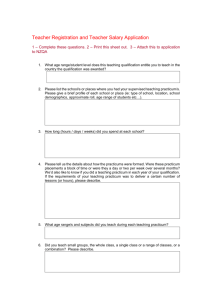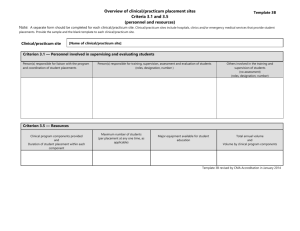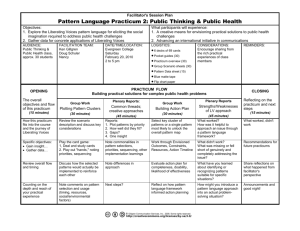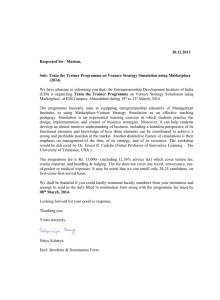zicklin school of business - Blogs@Baruch
advertisement
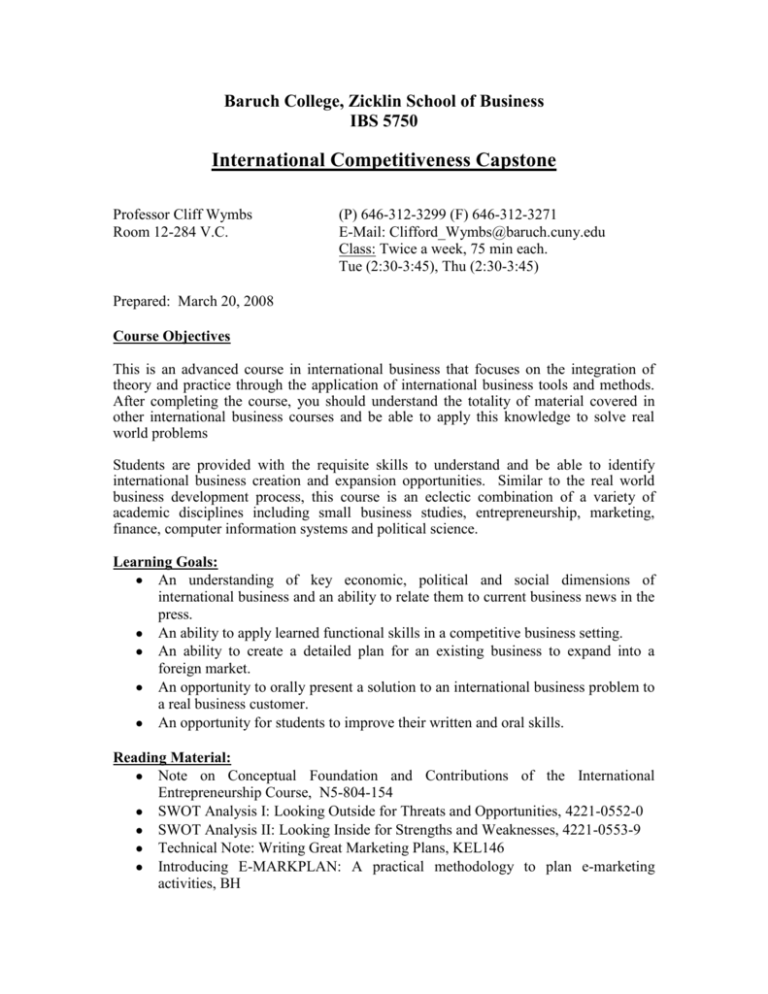
Baruch College, Zicklin School of Business IBS 5750 International Competitiveness Capstone Professor Cliff Wymbs Room 12-284 V.C. (P) 646-312-3299 (F) 646-312-3271 E-Mail: Clifford_Wymbs@baruch.cuny.edu Class: Twice a week, 75 min each. Tue (2:30-3:45), Thu (2:30-3:45) Prepared: March 20, 2008 Course Objectives This is an advanced course in international business that focuses on the integration of theory and practice through the application of international business tools and methods. After completing the course, you should understand the totality of material covered in other international business courses and be able to apply this knowledge to solve real world problems Students are provided with the requisite skills to understand and be able to identify international business creation and expansion opportunities. Similar to the real world business development process, this course is an eclectic combination of a variety of academic disciplines including small business studies, entrepreneurship, marketing, finance, computer information systems and political science. Learning Goals: An understanding of key economic, political and social dimensions of international business and an ability to relate them to current business news in the press. An ability to apply learned functional skills in a competitive business setting. An ability to create a detailed plan for an existing business to expand into a foreign market. An opportunity to orally present a solution to an international business problem to a real business customer. An opportunity for students to improve their written and oral skills. Reading Material: Note on Conceptual Foundation and Contributions of the International Entrepreneurship Course, N5-804-154 SWOT Analysis I: Looking Outside for Threats and Opportunities, 4221-0552-0 SWOT Analysis II: Looking Inside for Strengths and Weaknesses, 4221-0553-9 Technical Note: Writing Great Marketing Plans, KEL146 Introducing E-MARKPLAN: A practical methodology to plan e-marketing activities, BH Questions Every Entrepreneur Must Answer, Bhide, A.V. HBR Article 96603. Player’s Guide to link The Business Strategy Game www.bsg-online.com Reading packet (to be provided) Course Description: The course is composed of three interrelated components. The first provides students with the requisite skills to perform the remaining segments. The second component of the course involves a business strategy simulation and the third component involves an international business-consulting project with a real client. Requisite Skills Building on their international business course work, students are taught the fundamental concepts associated with international entrepreneurship, business planning, market planning and SWOT analysis. Students are expected to produce high quality written and oral reports produced in a business environment. The Business Strategy Game The simulation game is an online exercise where class members are divided into 5 to 7 member teams and assigned the task of running an athletic footwear company in head-tohead competition against companies managed by other class members. Company operations parallel those of actual athletic footwear companies. Just as in the real-world, companies compete in a global market arena, selling branded and private-label athletic footwear in four geographic regions — Europe-Africa, North America , Asia-Pacific, and Latin America. Company co-managers must make decisions relating to plant operations, distribution and warehouse operations, work force compensation, online sales at the company’s web site, sales and marketing, and finance. The challenge is to craft and execute a competitive strategy that results in a respected brand image, keeps your company in contention for global market leadership, and produces good financial performance as measured by earnings per share, return on investment, stock price appreciation, and credit rating. Each game involves two rounds of five moves each, and each round is graded separately. In addition, a critical written analysis of a global company is required. A quiz on the game and its functions is given near the middle of the semester. Students will explain how to develop a strategic plan that will differentiate an MNC from the others in order to gain a competitive advantage. They will write a SWOT analysis and describe the current situation of an existing company that assesses the major issues of the company and its current strategies. They will then evaluate the strategy in order to make a strategic recommendation for the company. The Practicum Project The focus on the practicum part of the course involves integrating theory and practice through the application of international business tools and methods. Students work in consulting teams with the SBDC to assist local companies exploring a new international market by providing a detailed market research report and summary presentation to the client. The course will feature guest speakers that are experts in various aspects of international trade. Typically, small businesses pay consulting firms in excess of $30,000 to find out if it is feasible for them to expand into foreign markets. But this semester, five companies will gain professional-quality information at no cost — thanks to 50 students in the Zicklin School of Business’ international business capstone. This Fall, student teams will help five small- to mid-sized firms in the New York City region devise market-entry strategies for breaking into foreign markets. On Dec. 7, the students will present their recommendations to the client. By participating in the course, students are graduating with international business knowledge. We are preparing them for the real world and giving them practical knowledge and tools that will help them succeed in the global marketplace once they have graduated. In addition to making presentations, each group also will be required to write a 50-page market/SWOT analysis detailing their findings. Communication-Intensive Course This class will be a communication intensive course that will emphasize the following BBA Learning Goals: analytical skills, oral and written communication. Since this is a communication-intensive class, an expert from the Schwartz Center has been assigned to assist you. The Schwartz consultant will meet with the project groups to work on presentation skills prior to the formal class presentation. Each group will be required to set up a meeting with the consultant for this purpose. You should regard this as an important opportunity to improve your presentation skills prior to your entering the job market. Students have the option to set up an additional meeting with the consultant in order to obtain help with a draft of the group project or with individual written work. Code of Conduct Academic dishonesty includes, but is not limited to cheating, plagiarism, collusion, sabotage, and falsification of records. For clarification and definitions see College’s Academic Honesty Website: www.baruch.cuny.edu/academic/academic_honesty.html. Penalties can be severe and are determined by the instructor on a case-by-case basis. Grading Class Participation Mid-Term Exam (case) Simulation Practicum Paper Presentation 5% 25% 20% 50% 30% 20% Final (case) optional Total 100% Class Participation: Students are expected to have read the assigned material and to actively participate in class discussions. Mid Term Exam: A mid-term exam will be a case analysis covering course material. The exam will be closed book, but you are allowed one page (one side) of notes. Simulation: Present strategic summaries of your team’s most recent position, why you expected your strategy would work, what happened that was unanticipated, and what you will do in the next round. Upon completion of the simulation describe what happen, what when right, what when wrong and what you learned and what you would do differently. Group Project: Teams of five to seven people are to be formed. The main output is a market entry plan for your target company. As part of the plan, students will perform a SWOT-like analysis of their company (for entry into a particular foreign market). The write-up should be approximately 50 pages. Students will present their recommendations to the company. A 30 minute presentation with Power Point slides will be performed. Final Exam: Optional The final exam will be a case analysis similar to the mid-term. The exam will be closed book, but you are allowed one page (one side) of notes. If you choose this option, your highest grade on the mid-term or final will be doubled and then averaged. If you choose not to take the final, your mid-term grade will be used. Syllabus (1) August 31 - Course Overview Provides a general assessment of the course demands and areas to be covered. Objectives Requirements Methods (2) (3) (4) September 5, 7, & 12– The International Entrepreneurial Process What is an entrepreneur and what opportunities are present? A Perspective on Entrepreneurship, Sahlman: Stevenson, Chapter 1 Questions Every Entrepreneur Must Answer, Bhide, A.V. HBR Article 96603. Note on Conceptual Foundation and Contributions of the International Entrepreneurship Course September 12 - Teams of 5-7 members are formed (5) (6) September 14 & 19– Developing an Overall Assessment Framework Develops a framework for assessing new opportunities and the business plans used to describe them. It places the business plan in the proper context associated with the process of developing new business opportunities. SWOT Analysis I: Looking Outside for Threats and Opportunities, Note SWOT Analysis II: Looking Inside for Strengths and Weaknesses, Note Some Thoughts on Business Plans. HBS Note 897101. (7) September 21 – Marketing Framework Provide examples of ways to explore market expansion Managing Global Expansion: A Conceptual Framework, Note Writing Great Marketing Plans, Note (8) (9) September 26 & 28 – Cases Discussion of the cases will demonstrate the above assessment framework. Teams will prepare answers and lead class discussion of parts of the following cases. Tata Consulting Services Iberoamerica Crocs: Revolutionizing an Industry’s Supply Chain for Competitive Advantage, Case Wal-mart Stores: Everyday Low Prices in China Chemdex (10) October 3 – Simulation Cases Overview: Orientation; form teams; game introduction; give out game codes (11) October 5 – Mid-term Exam (12) October 12 - International Business Research Louis from library staff will present approaches to International Business Research (13) October 17 – Simulation: Presentation and Analysis by professor of sample moves (14) October 24 – Discussion of the Practicum Project (15) October 26 – Simulation 1 Presentations Four groups (16) October 31- Teams assigned companies and meet to discuss practicum and obtain teacher feedback. (17) November 2 – Simulation 2 Presentations Four groups (18) November 7 - Teams meet during class time to work on practicum (19) November 9 – Simulation 3 Presentations Four groups (20) November 14 - Teams meet during class time to work on practicum and obtain teacher feedback. (21) November 16 – Simulation 4 Presentations Four Groups (22) November 21 - Teams meet during class time to work on practicum and obtain teacher feedback. (23, 24, 25, 26 & 27) November 28 & 30, December 5 & 7 - Student Group Business Plan Presentations Student presentations, depending on company schedules (28) December 12 - Course Wrap-up Practicum Paper due I will summarize the strengths and weaknesses of the presentations and provide my overall review of what students should have gotten out of the course.

